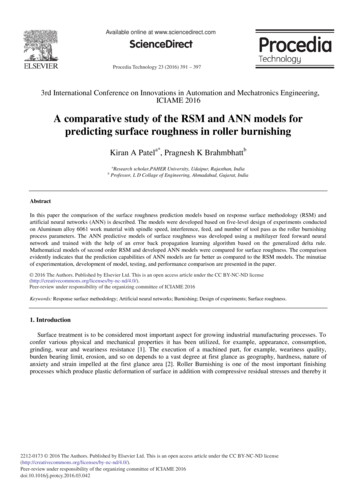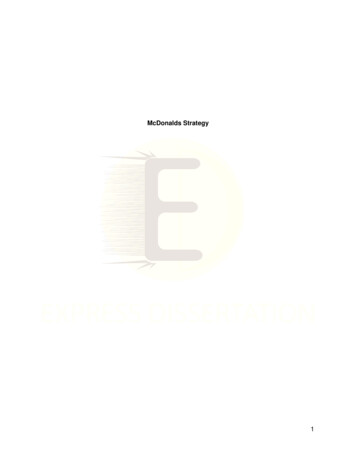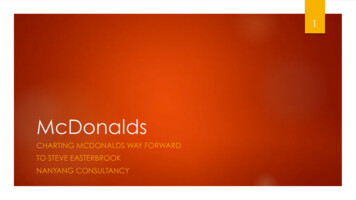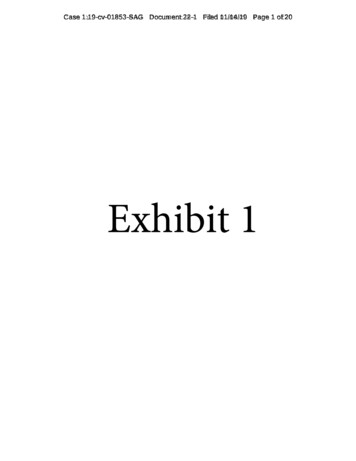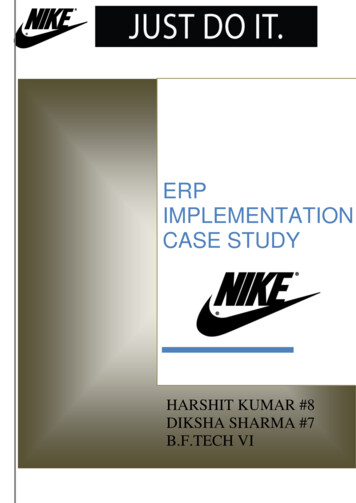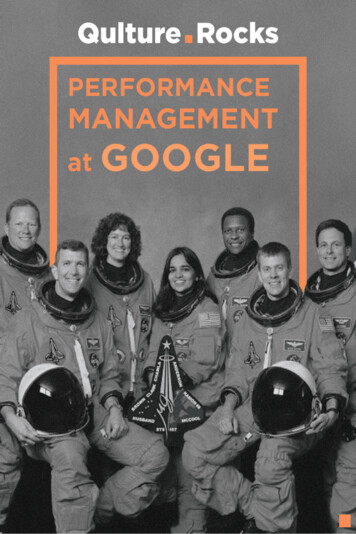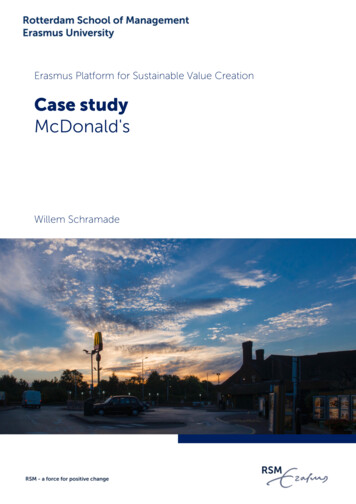
Transcription
Erasmus Platform for Sustainable Value CreationCase studyMcDonald'sWillem Schramade
McDonald's:a sustainablefinance case studySeptember 2019Willem SchramadeErasmus Platform for Sustainable Value CreationImportant: this company analysis was done for educational purposes. It is notan investment recommendation nor does it in any way reflect the opinion ofRSM, Erasmus University. Target prices were calculated only to illustrate ways ofthinking about value.
Abstract4Introduction5The list of questions6Answering the questions for McDonald's9Conclusions and reflections27References28Important: this company analysis was done for educational purposes. It is notan investment recommendation nor does it in any way reflect the opinion ofRSM, Erasmus University. Target prices were calculated only to illustrate ways ofthinking about value.3 Erasmus Platform for Sustainable Value Creation
1AbstractThis is the third1 in a series of RSM case studies on sustainable finance. Using a listof questions, we show how to integrate sustainability into investment analysis byconnecting sustainability to business models, competitive position, strategy andvalue drivers. Here the questions are answered for McDonald’s, a company thatfaces substantial sustainability challenges, on both the social (health) andenvironmental (footprint) dimensions. Our findings suggest that McDonald’s is notas well positioned as Philips, but much better than Air France-KLM. Unlike thelatter, McDonald’s does have significant options to deal with its sustainabilityissues. However, our ability to properly assess its transition preparedness ishampered due to the absence of essential data: McDonald’s sustainabilityreporting is limited and lacks targets and numbers. Unfortunately, this is typical ofcurrent reporting practices.After Philips (https://www.rsm.nl/fileadmin/Images NEW/Erasmus Platform for Sustainable Value Creation/Case Study Sustainable Finance Royal Philips.pdf) and Air France-KLM (https://www.rsm.nl/fileadmin/Images NEW/Erasmus Platform for Sustainable Value Creation/Case study KLM 01.pdf)14 Erasmus Platform for Sustainable Value Creation
2IntroductionIn this case study we analyse McDonald’s, a company that faces substantialsustainability headwinds.We chose McDonald’s because it highlights the predicament of a company thatperforms very well financially as long as its negative externalities are notinternalized. Like the other cases in this series (on Philips and Air France-KLM), itpresents a list of questions that allow analysts to integrate sustainability intoinvestment analysis by connecting sustainability to business models, competitiveposition, strategy and value drivers.Our finding suggest that McDonald’s is not as well positioned as Philips to meet itssustainability challenges. Like Air France-KLM, McDonald’s faces serioussustainability challenges both on the social (health) and environmental (carbonfootprint) side. However, its odds of overcoming these headwinds look muchbetter than at Air France-KLM: McDonald’s is more profitable, more advanced interms of sustainability reporting and thinking, and it has significant options to dealwith these issues. For example, the company has taken initiatives to make its foodhealthier but encountered lukewarm consumer response; and its supply chaininitiatives look promising, be it with the suspicion of green washing. However, itneeds to be emphasized that essential data is missing as McDonald’s sustainabilityreporting is limited and lacks targets and numbers. This puts a large question markon the company’s transition preparedness. Investor engagement could alleviatethis problem.Like the other cases in this series, this one highlights the need for fundamentalanalysis (that is, going well beyond ESG ratings) to properly assess a company’stransition preparedness, which we deem the essence of corporate sustainability.This article is set up as follows: in the next section, the list of questions ispresented. In the subsequent section, the questions are answered for McDonald’s,starting with the company’s business model and value drivers, before diving intostrategy and sustainability. It then goes back to the value drivers and theinvestment case to see how they have been affected by the sustainability analysis.In this way, the analyst develops a holistic view of the company. The final sectionconcludes and reflects.5 Erasmus Platform for Sustainable Value Creation
3The list of questionsThe below list of questions (Table 1) has been made over the course of severalyears of doing ESG integrated investment analysis, and is exactly the same as inthe Philips case. More recently, they have been structured as an assignment forthe Sustainable Finance course taught at Erasmus University and can be found inour Sustainable Finance textbook (Schoenmaker and Schramade, 2019, Chapter8).They are meant to deepen students’ and practitioners’ understanding of ESGintegration by having them apply sustainable finance insights to a real life example– and ideally discuss with fellow students or colleagues. They are 25 questions(even more including sub-questions) in six sections. Although the six sectionsaddress different issues, it should become obvious during the analysis that they arevery much related.TABLE 1 LIST OF SUSTAINABLE FINANCE QUESTIONS FOR ESG INTEGRATIONSection1. Businessmodel &competitiveposition2. Value drivers(part 1)Questions1.How would you describe the company’s business model?2.How strong do you rate the company’s competitive position?3.What trends affect the company’s business model and competitiveposition?1.Sales growth: what seems to be a normal sales growth for thecompany? And what are the drivers of sales growth?2.Margins: what seems to be a normal profit margin (EBIT or EBITDA)for the company? And what are the drivers of that margin?3.Capital: how capital intense is the company? What do you think isthe firm's cost of capital? What is the firm's return on invested capital(ROIC)4.Please sketch how you see the company’s value drivers goingforward?6 Erasmus Platform for Sustainable Value Creation
1.Purpose: what is the company's mission / purpose / raison d'être? Inwhat way does the company create value for society? How does itget paid for that value creation?2.Stakeholders: what are the company's main stakeholders? Please fillout the stakeholder impact tool3.Externalities & impact: Does the company generate seriousexternalities? Are they positive or negative? How do you assess thechances of these externalities to be internalized? Thresholds: howdoes the company perform versus the planetary boundaries?4.SDGs: which of the SDGs (if any) does the company help achieve?Which negative SDG exposures (if any) does the company have?3. Sustainability5.Impact: to what extent can the company’s impact be measured?Does the company report on its impact? How can its impact reportingbe improved?6.Material issues: what are the most material ESG factors? I.e., whatissues are most critical to the success of the company's businessmodel? Please fill out the given matrix, discussing for each of thesemost material ESG factors (1) how the company performs on it; (2)whether the company derives a competitive (dis)advantage from it; (3)how they might affect the value drivers7.Sustainability reporting: how do you assess the company’s nonfinancial reporting? Does the company (claim to) do IntegratedReporting ( IR )? To what extent do you see the seven principles of IR reflected in the company’s reporting?1.How would you describe the strategy of the company?2.To what extent does that strategy take into account the company'smost material ESG issues? Please link to your answer in thesustainability section.3.Is the strategy consistent with the company's purpose?4. Strategy4.What does long-term value creation look like? What are the bestKPIs for it?5.What does management compensation look like? To what extentdoes management have long-term incentives? And are thoseincentives aligned with long term-value creation?5. Value drivers(part 2)6.How does the company communicate its long-term value creationwith shareholders and stakeholders?1.Given all of the above questions & their answers, how do you ratethe effect of material sustainability issues on the value drivers goingforward? Per value driver, please indicate whether you see a positive,negative or neutral effect2.How would this affect your valuation of the company?7 Erasmus Platform for Sustainable Value Creation
1.How well prepared do you think McDonald's is for the transition to amore sustainable economic model?6. Investmentconclusions2.How attractive do you find the company as an investment?3.What did you find most surprising when answering the abovequestions?4.If you were to engage with the firm, what topics would you address?Source: authorsOf course, these questions can be answered either very high level or in a verydetailed way. And not all questions will need to be answered every time or rightaway. Ideally, priorities will depend on the needs of the user and the relevance ofthe particular issue in the context at hand. It certainly should not be a matter ofperfectionism or box-ticking, as answering the questions is not a goal in itself butmeant to build a good holistic understanding of a company’s transitionpreparedness and investment attractiveness.8 Erasmus Platform for Sustainable Value Creation
4Answering the questionsfor McDonald'sIn this section, the questions are answered for McDonald’s. We answered thequestions based on publicly available material. Ideally, the answers serve as auseful illustration and help answering the same or similar questions for differentcompanies as well.1.Business model & competitive positionSee Chapter 5 of Schoenmaker and Schramade (2019) for a description of thebelow concepts and how they relate to each other.Business model & competitive position1.1. How would you describe the company’s business model? Whatare its customer value proposition and profit formula? 2McDonald's is the world's largest restaurant chain with 36,000 stores in over 100countries. The vast majority ( 90%) of these stores are run as franchises. As theysay it3: “The power of our franchisees, suppliers and employees working togethertoward a common goal is what makes McDonald’s the world’s leading quickservice restaurant brand”. And McDonald's founder Ken Croc defined its valueproposition in this way: “McDonalds stands for friendliness, cleanliness,consistency, and convenience”.The company essentially has two profit formulas: One for the restaurants the company owns, where it gets all revenues and bearsall costs; And one for the franchised restaurants, where it gets rent payments, and royaltyfees that depend on a percentage of the franchisees’ sales.Johnson et al. (2008) argue that a successful business model has three components:1. the model helps customers perform a specific ‘job’ that alternative offerings do not address;2. the model generates value for the company through factors such as the revenue model, cost structure, marginsand/or inventory turnover;Key resources and processes: the company has the people, technology, products, facilities, equipment and brandrequired to deliver the value proposition to targeted customers. The company also has processes (training,manufacturing, services) to leverage those d/about-us/our-business-model.html9 Erasmus Platform for Sustainable Value Creation
At the latter, the company’s revenues are lower, but its margins are much higher.Although franchised restaurants remain independent and manage their day-to dayoperations themselves, McDonald’s supervises them and controls the quality offood and services. In company-owned restaurants, McDonald’s develops and testsinnovations, improve operations and pricing, and train employees. McDonald’sowns the land and buildings (or has long-term financial leases), so that it has agreater control over franchises and a source of additional income. McDonald’ssubleases restaurants with a 40% mark-up.1.2. How strong do you rate the company’s competitive position?McDonald’s enjoys a strong competitive position in the Informal Eating Outsegment (IEO) versus peers such as Burger King and KFC. Its major strength is itsnetwork: franchises, landowners, and supply chain. The franchise model allowsMcDonald’s to expand without overcomplicating the management system.McDonald’s focuses on the development of the brand by setting standards for thefood chain, doing market research and advertisement. Moreover, the modelpreserves incentives for managers of restaurants, who are at the same time selfemployers. The model also allows McDonald’s to serve locally relevant foodbecause restaurants are run by local entrepreneurs who are familiar with regionalfood preferences.The company’s position is not undisputed however, and the market has becomemore blurred with the competition from new entrants: online delivery platformsand convenience and grocery stores.1.3. What trends affect the company's business model andcompetitive position?Several trends can be identified: Urbanization and a growing middle class in emerging markets drive demand formeat4 and fast food restaurants – a clear positive for McDonald’s Digitalization. Customers have become more used to technological innovationsand require higher quality services. Greater customer experience can beachieved through digitalization of delivery and services in the restaurants.Moreover, digitalization can reduce costs and optimize the control over thesupply chain – an opportunity for McDonald’s to further expand its scaleadvantage over competitors, but also a threat from online delivery companies. Increasing health awareness due to the surge in chronic diseases like diabetes a threat for McDonald’sGlobal meat production grew almost 2% per year over the past decade and is expected to grow by 1% per year over the next decade
operations themselves, McDonald’s supervises them and controls the quality of food and services. In company-owned restaurants, McDonald’s develops and tests innovations, improve operations and pricing, and train employees. McDonald’s owns the land and buildings (or has long-term financial leases), so that it has a
